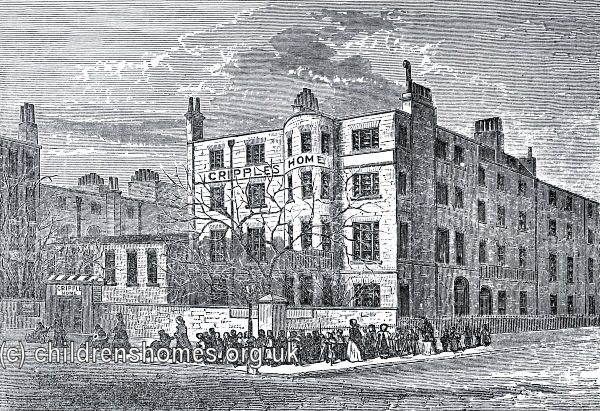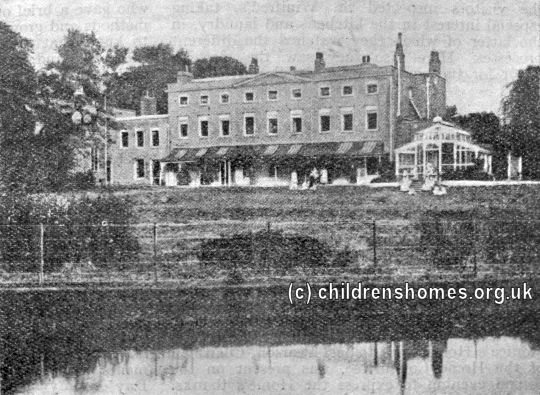Cripples' Home and Industrial School for Girls
The Hill Street Refuge for Girls was founded in 1851 by Mrs Caroline Blunt. It was originally located at Hill Street, near Dorset Square, in Marylebone. It particularly catered for girls with physical disabilities and became known as 'The Cripples' Home'. In the early 1860s, it typically had about 60 girls in residence. On 23rd March, 1859, the Home became officially certified as an Industrial School allowing it to take girls committed by magistrates. However, the large majority of its residents were voluntary cases.
In 1864, the Home moved to new premises at Northumberland House, 17a Marylebone Road, at the corner of Northumberland Street (now Luxborough Street). On February 27th of that year was re-certified as an Industrial School. The girls were given lessons in reading and writing by ladies from the home's Committee. They were also given industrial training in the form of straw plaiting, straw hat making and needlework.

Cripples' Home, Marylebone Road, c.1877. © Peter Higginbotham
By 1874, there 98 girls in residence: 69 'cripples', and 29 'industrial cases of whom only 5 were there under detention. Dressmaking was being introduced and a great deal of laundry work was being carried out. The domestic work of the Home was being performed by the 'industrial' inmates who also attended to the wants of the 'cripples'. The institution was described by an inspector as having a 'kindly benevolent spirit'. The Home relinquished its Industrial School status in 1877.
In 1911, the Home moved to 'Halliwick' on Bush Hill Road, Winchmore Hill, in north London. The 300-year-old house, with spacious grounds, was the former residence of Sir Hugh Myddleton, a 17th century politician merchant and engineer. Myddleton was responsible for a pioneering project to channel clean water to London from the River Lea in Hertfordshire via a channel known as the New River which still runs through the former grounds of the now demolished house.
In 1927, the Home was handed over to the Waifs and Strays Society and became the Halliwick School For Girls.

Halliwick and the New River, Winchmore Hill, c.1927. © Peter Higginbotham
Records
Note: many repositories impose a closure period of up to 100 years for records identifying individuals. Before travelling a long distance, always check that the records you want to consult will be available.
- Index of the Society's first 30,000 children's case files ordered by surname.
- Index of the Society's first 30,000 children's case files ordered by date of birth.
- The Children's Society Records and Archive Centre is at Unit 25, Springfield House, 5 Tyssen Street, London E8 2LZ (email: archives@childrenssociety.org.uk). Files for children admitted to its homes after September 1926 were microfilmed in the 1980s and the originals destroyed. Some post-1926 files had already been damaged or destroyed during a flood. The Society's Post-Adoption and Care Service provides access to records, information, advice, birth record counselling, tracing and intermediary service for people who were in care or adopted through the Society.
- The Society has produced detailed catalogues of its records relating to disabled children, and of records relating to the Children's Union (a fundraising body mostly supported from the contributions of children).
Bibliography
- Bowder, Bill Children First: a photo-history of England's children in need (1980, Mowbray)
- Church of England Waifs and Strays' Society [Rudolfe, Edward de Montjoie] The First Forty Years: a chronicle of the Church of England Waifs and Strays' Society 1881-1920 (1922, Church of England Waifs and Strays' Society / S.P.C.K.)
- Higginbotham, Peter Children's Homes: A History of Institutional Care for Britain's Young (2017, Pen & Sword)
- Morris, Lester The Violets Are Mine: Tales of an Unwanted Orphan (2011, Xlibris Corporation) — memoir of a boy growing up in several of the Society's homes (Princes Risborough, Ashdon, Hunstanton, Leicester) in the 1940s and 50s.
- Rudolf, Mildred de Montjoie Everybody's Children: the story of the Church of England Children's Society 1921-1948 (1950, OUP)
- Stroud, John Thirteen Penny Stamps: the story of the Church of England Children's Society (Waifs and Strays) from 1881 to the 1970s (1971, Hodder and Stoughton)
Links
- Hidden Lives Revealed — the story of the children who were in the care of The Children's Society in late Victorian and early 20th Century Britain.
- The Children's Society
Except where indicated, this page () © Peter Higginbotham. Contents may not be reproduced without permission.


